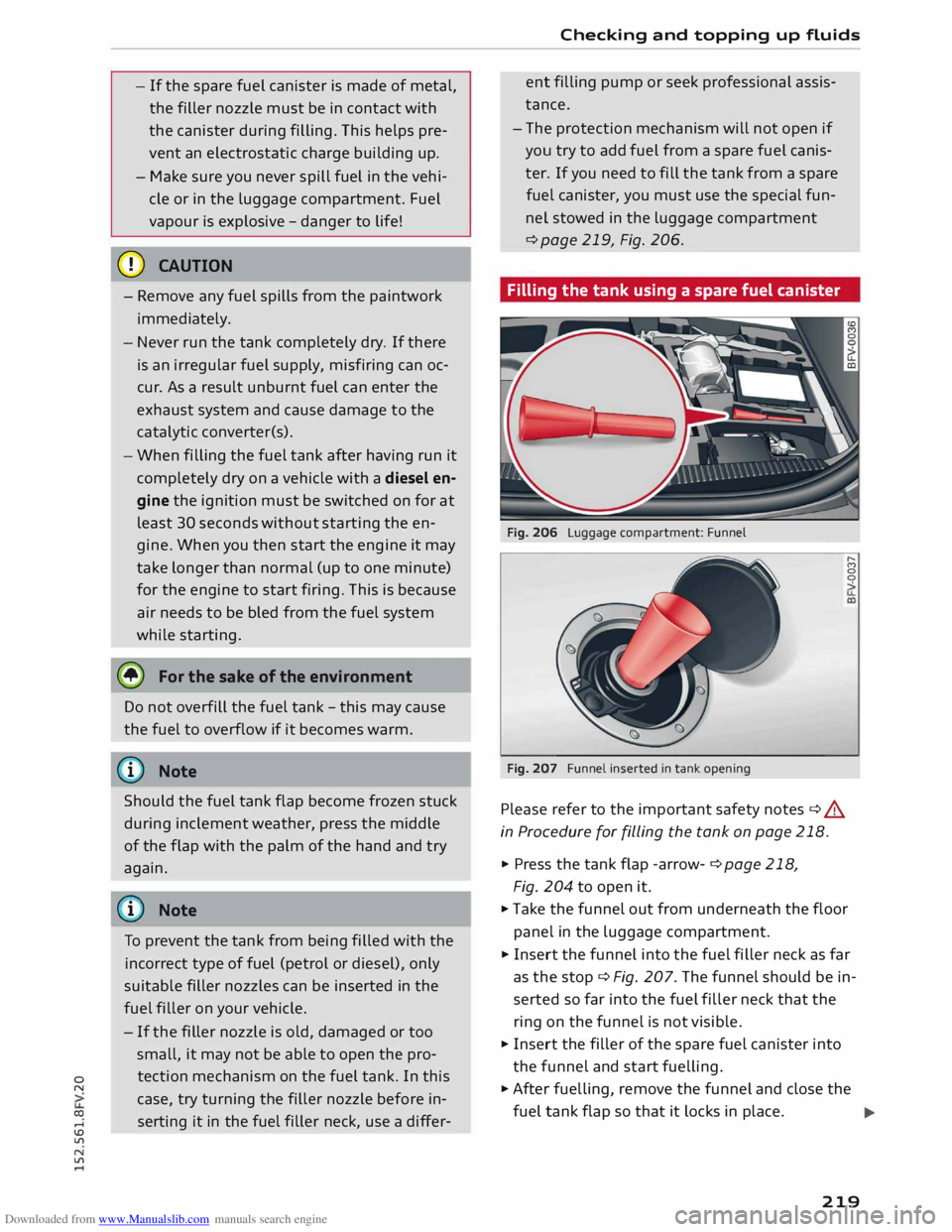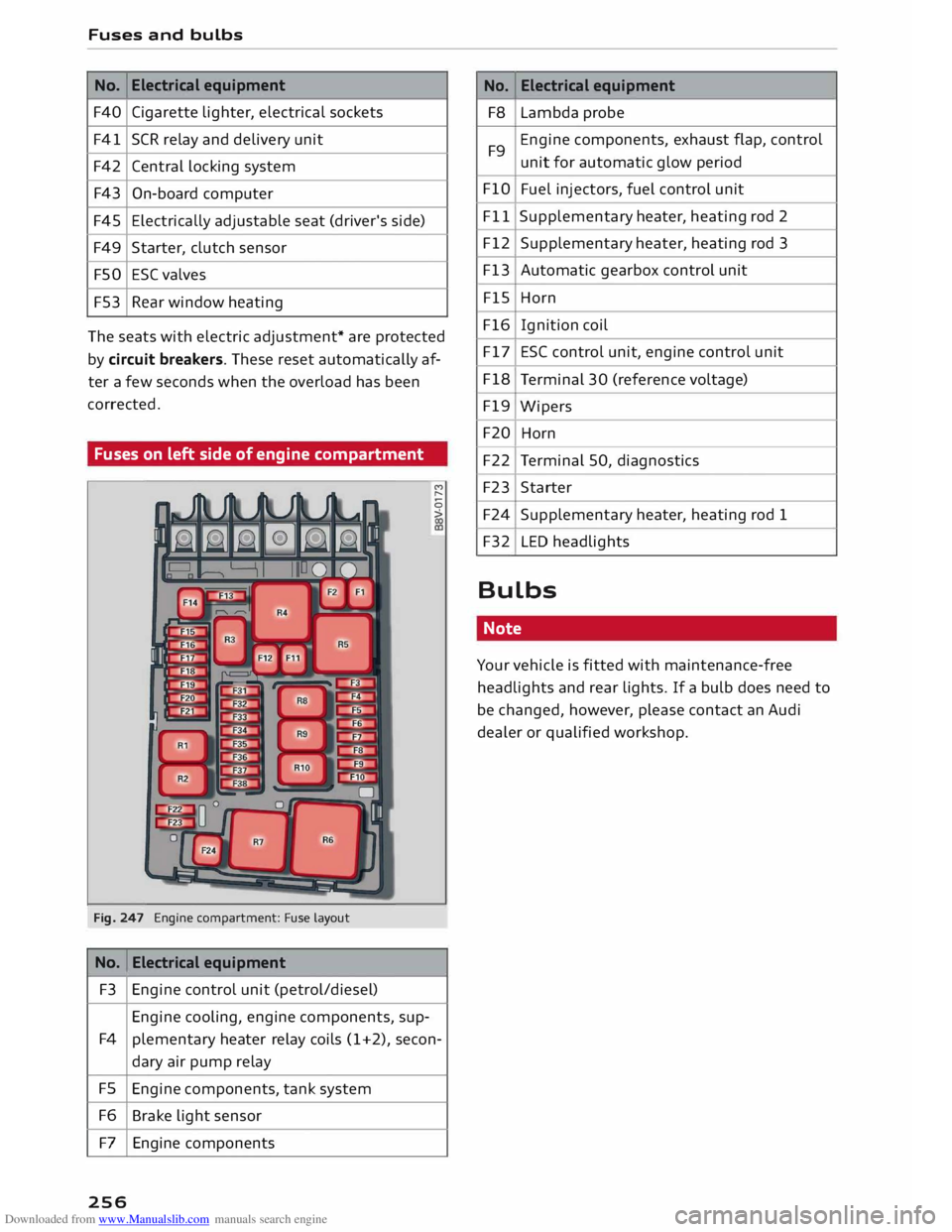fuel pump AUDI TT COUPE 2014 Owners Manual
[x] Cancel search | Manufacturer: AUDI, Model Year: 2014, Model line: TT COUPE, Model: AUDI TT COUPE 2014Pages: 284, PDF Size: 34.42 MB
Page 220 of 284

Downloaded from www.Manualslib.com manuals search engine Checking
and topping up fluids
Diesel can thicken at very low temperatures,
which can result in problems starting the engine
or prevent the engine from running smoothly. For
this reason, filling stations in some countries of
fer winter-grade diesel fuel during the cold
months so that you can continue to operate your
vehicle reliably. Ask at your filling station wheth
er the diesel fuel available there is suitable for
the current conditions and for the temperatures
which could potentially occur.
CD CAUTION
- Never use FAME fuels (biodiesel), petrol,
heating oil, thinners or any other fuels or
additives, as these could cause serious dam
age to the fuel system and the engine.
- Never start the engine if you fill up with the
wrong type of fuel, as this could damage
the fuel system and the engine. Obtain pro
fessional assistance.
Filling the tank
Procedure for filling the tank
Fig. 204 Vehicle as seen from the rear right: Opening the
fuel tank flap
Fig. 205 Inserting the filler nozzle
The fuel tank flap is unlocked and locked auto
mati cally by the central locking system.
218 "'
N
00
0
00
ca �
Press the tank flap -arrow- ¢ Fig. 204 to open
it. Your vehicle has a new self-sealing fuel tank
without a tank cap.
� Insert the filler nozzle into the fuel filler neck
as far as the stop ¢ Fig. 205 and ensure it is
properly engaged.
� Start refuelling. When the automatic filler noz
zle is operated correctly it will switch itself off
as soon as the tank is "full". Do not try to put in
more fuel after the nozzle cuts out, as this will
fill the expansion chamber in the fuel tank.
� When the fuel filler pump switches itself off,
wait for 5 seconds before pulling out the filler
nozzle so that any remaining fuel can flow into
the tank opening.
� Close the tank flap. Make sure you hear it click
into place.
The correct fuel grade for your vehicle is given on
a sticker on the inside of the tank flap. Further
notes on fuel ¢page 217.
The tank capacity of your vehicle is given in the
Technical data section ¢ page 258.
& WARNING
Fuel is highly inflammable and can cause seri
ous burns and other injuries.
- For safety reasons we do not recommend
carrying a spare fuel canister in the vehicle.
The canister could become damaged in an
accident and leak.
- Observe all relevant statutory regulations
on using, storing and transporting spare
fuel canisters.
- When filling your tank or a spare fuel canis
ter with fuel, do not smoke and keep away
from naked flames -risk of explosion!
- If,
in exceptional circumstances, you have to
carry a spare fuel canister, please observe
the following warnings:
- Never fill fuel into the spare fuel canister
with the canister placed in or on top of the
vehicle. An electrostatic charge could
build up during filling, causing the fuel va
pour to ignite -risk of explosion! Always
place the canister on the ground to fill it.
- Insert the filler nozzle as far as possible
into the spare fuel canister.
Page 221 of 284

Downloaded from www.Manualslib.com manuals search engine 0
N
co
....
\D Lfl
N
Lfl
.... -
If the spare fuel canister is made of metal,
the filler nozzle must be in contact with
the canister during filling. This helps pre
vent an electrostatic charge building up.
- Make sure you never spill fuel in the vehi
cle or in the Luggage compartment. Fuel
vapour is explosive -danger to Life!
CD CAUTION
- Remove any fuel spills from the paintwork
immediately.
- Never run the tank completely dry. If there
is an irregular fuel supply, misfiring can oc
cur. As a result unburnt fuel can enter the
exhaust system and cause damage to the
cata Lytic converter(s).
- When filling the fuel tank after having run it
completely dry on a vehicle with a diesel en
gine the ignition must be switched on for at
Least 30 seconds without starting the en
gine. When you then start the engine it may
take Longer than normal (up to one minute)
for the engine to start firing. This is because
air needs to be bled from the fuel system
while starting.
(® For the sake of the environment
Do not overfill the fuel tank -this may cause
the fuel to overflow if it becomes warm.
(1j) Note
Should the fuel tank flap become frozen stuck
during inclement weather, press the middle
of the flap with the palm of the hand and try
again.
@ Note
To prevent the tank from being filled with the
incorrect type of fuel (petrol or diesel), only
suitable filler nozzles can be inserted in the
fuel filler on your vehicle.
- If the filler nozzle is old, damaged or too
small, it may not be able to open the pro
tection mechanism on the fuel tank. In this
case, try turning the filler nozzle before in
serting it in the fuel filler neck, use a differ- Checking
and topping up fluids
ent filling pump or seek professional assis
tance.
- The protection mechanism will not open if
you try to add fuel from a spare fuel canis
ter. If you need to fill the tank from a spare
fuel canister, you must use the special fun
nel stowed in the Luggage compartment
¢page 219, Fig. 206.
Filling the tank using a spare fuel canister
Fig. 206 Luggage compartment: Funnel
Fig. 207 Funnel inserted in tank opening
Please refer to the important safety notes¢ A
in Procedure for filling the tank on page 218.
... Press the tank flap -arrow- ¢page 218,
Fig. 204 to open it. .....
(')
0
0
... Take the funnel out from underneath the floor
panel in the Luggage compartment.
... Insert the funnel into the fuel filler neck as far
as the stop ¢ Fig. 207. The funnel should be in
serted so far into the fuel filler neck that the
ring on the funnel is not visible.
... Insert the filler of the spare fuel canister into
the funnel and start fuelling.
... After fuelling, remove the funnel and close the
fuel tank flap so that it Locks in place.
llJl,,
219
Page 258 of 284

Downloaded from www.Manualslib.com manuals search engine Fuses
and bulbs
No. Electrical
equipment
F40 Cigarette lighter, electrical sockets
F41 SCR relay and delivery unit
F42 Central locking system
F43 On-board computer
F45 Electrically
adjustable seat (driver's side)
F49 Starter, clutch sensor
FSO ESC
valves
F53 Rear window heating
Th e seats with electric adjustment* are protected
by circuit breakers. These reset automatically af
ter a few seconds when the overload has been
corrected.
Fuses on left side of engine compartment
Fig. 247 Engine compartment: Fuse la
yout
No. Electrical
equipment
F3 Engine control unit (petrol/diesel)
Engine cooling, engine components, sup-M
,...,
0
>
F4 plementary heater relay coils (1+2), secon-
dary air pump relay
FS Engine components, tank system
F6 Brake light sensor
F7 Engine components
256 No.
Electrical
equipment
F8 Lambda probe
F9 Engine
components, exhaust flap, control
unit for automatic glow period
FlO Fuel injectors, fuel control unit
Fll Supplementary
heater, heating rod 2
F12 Supplementary heater, heating rod 3
F13 Automatic gearbox control unit
FlS Horn
F16 Ignition coil
F17 ESC control unit, engine control unit
F18 Terminal 30 (reference voltage)
F19 Wipers
F20 Horn
F22 Terminal 50, diagnostics
F23 Starter
F24 Supplementary heater, heating rod 1
F32 LED headlights
Bulbs Note
Your vehicle is fitted with maintenance-free
headlights and rear lights. If a bulb does need to
be changed, however, please contact an Audi
dealer or qualified workshop.